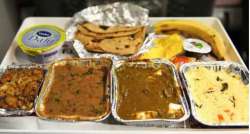Delhi, Ahmedabad tops list of 7 cities in daily average consumption of 'added fat': ICMR survey
Delhi and Ahmedabad topped the list of seven metro cities in daily average consumption of 'added fat' in dishes such as dal fry, stuffed paratha and mutton biryani, while Hyderabad was at the bottom of the list according to a recent survey.

Delhi and Ahmedabad topped the list of seven metro cities in daily average consumption of 'added fat' in dishes such as dal fry, stuffed paratha and mutton biryani, while Hyderabad was at the bottom of the list according to a recent survey. The Indian Council of Medical Research (ICMR) survey also revealed that men consume more fat at 34.1 gram per person daily, than women who consume 31.1 gram per day across the seven cities -- Ahmedabad, Bengaluru, Chennai, Delhi, Hyderabad, Kolkata and Mumbai.
Added fat was high in dishes such as dal fry, rice, stuffed paratha, chuduva, bisi bele bath -- a rice-based dish with origins in Karnataka -- and puliyodharai also known as tamarind rice. Mutton Birynai has more fat than chicken biryani or cereal-based and non-vegetarian recipes, it found.
According to the study, those who eat deep-fried food consumed more added fat than those who ate boiled and shallow-fried food. Also, almost all non-vegetarian foods, mostly consumed in urban areas, has high amounts of added fat, the study revealed. The survey was carried out by Indian Council of Medical Research-National Institute of Nutrition (ICMR-NIN) from the database of National Nutrition Monitoring Bureau study (2015-16), ICMR-NIN-Hyderabad.
The analysis was supported by International Life Sciences Institute-India (ILSI-India). Professor P K Seth, the chairman of ILSI India, said added fat consumption levels were significantly higher in Delhi and Ahmedabad at 44.4 gram per person daily and 43.9 gram each day respectively. The average intake of added fat in Mumbai and Hyderabad were the lowest at 28.8 gram per person daily and 25.1 gram per person each day respectively, he said.
The average intake of added fat in all the seven metro cities pooled together was 32.6 gram per person each day, which was higher than ICMR-recommended levels at 20g/person/day. Overall, 18 per cent of the total intake of energy was obtained from visible fat, the survey found. About the methodology used for assessing added fat intake, Dr A Laxmaiah, the head of the division of Public Health Nutrition in NIN, said they evaluated the intake of an assortment of food such as regular home-made food, packaged food, sweet-based preparations, bakery and biscuits, and milk products to come out with the quantum of added fat across a fairly large sample of 5,123 individuals from 1,293 households.
The data was collected by the National Nutrition Monitoring Bureau (NNMB) and analysed by the Division of Public Health Nutrition, NIN. The collated data was also used to measure gender-wise consumption of added fat. The highest intake of added fat was observed in the age group of 36 to 59 (36.1 gram/person/day), followed by 18-35 age group (34.8 g/person/day) and adolescents (32.8 g/person/day). The least intake of added fat was noticed in children under the age of five (15.7/g/person/day).
The researchers noted that contrary to general belief, vegetarians consumed more fat (40.7 gram) than non-vegetarians (30.2 gram) in these seven metro cities. "It is important that people are motivated to have a balanced diet, adopt healthy lifestyle, undertake physical activity, including Yoga," Prof Seth said.
ALSO READ | National Museum drops non-veg dishes from menu of food event due to 'sentimental' reasons
ALSO READ | 7 Delicious Foods That Help Fight Belly Fat Immediately